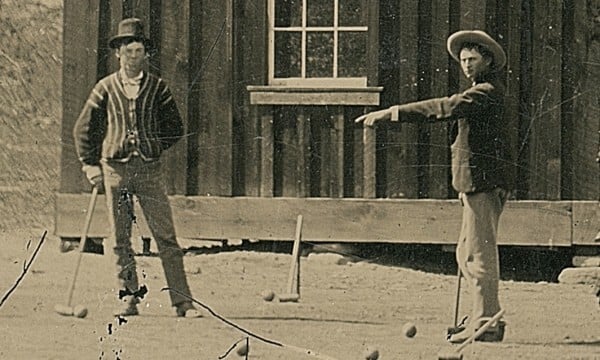
When Randy Guijarro picked up an old photo of a game of croquet at a Fresno junk shop for $2, he didn’t know that he was actually purchasing a priceless piece of American history. It is only the second confirmed photograph of Billy the Kid, an iconic figure of the Wild West.
The photograph, which shows Billy the Kid and his posse of Regulators enjoying a post-wedding game of croquet in 1878, was authenticated by Kagin’s, a San Francisco-based company that provides expertise in Western Americana and rare coins.
Billy the Kid’s only other verified photo, a tintype portrait, was purchased in 2011 at Brian Lebel’s annual Old West Auction in Denver for $2.3 million by billionaire Bill Koch, an avid collector of art of the American West (and emotional wine lover). The pre-sale estimate had topped out at just $400,000. According to Kagin’s website, the tintype of Billy the Kid playing croquet has been appraised and insured for $5,000,000.
Billy the Kidd.
Photo: Brian Lebel Auctions.
Born Henry McCarty in New York city, Billy the Kid headed west and turned to a life of crime, becoming a frontier outlaw. He owes his legendary status in part to the New Mexico governor, who placed a price on his head. Billy the Kid died in a gunfight in 1881 at just 21.
“An original Billy the Kid photo is the holy grail of Western Americana,” Kagin’s David McCarthy told the Guardian. “We had to be certain that we could answer and verify where, when, how and why this photograph was taken. Simple resemblance is not enough in a case like this.”
Kagin’s spent a year researching the image, tracking down the location where it was shot, locating the foundations of the building behind Billy the Kid and his friends in Chaves County, New Mexico.
Billy the Kid plays croquet, 1878.
Photo: Kagin’s.
If croquet seems an uncharacteristically genteel pursuit for such a notorious outlaw, you’d be surprised to learn that the sport had a downright unsavory reputation back in the day. According to James Charlton and William Thompson’s Croquet: The Complete Guide to History, Strategy, Rules, and Records, “it had become associated with gambling, drinking and philandering to such an extent that it was banned in Boston by one Reverend Skinner.”
Despite the excitement surrounding the photo’s discovery, it’s success at auction is far from guaranteed. Earlier this year, a photograph thought to contain the third extant photo of Vincent van Gogh failed to sell at auction.